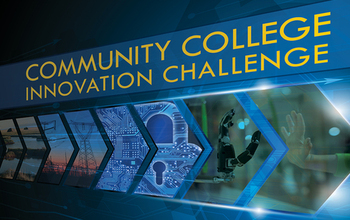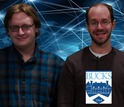News Release 17-032
Finalists for 2017 Community College Innovation Challenge announced
NSF, AACC oversee proposed solutions to important societal problems

NSF and AACC name the 10 finalists in third annual Community College Innovation Challenge.
April 10, 2017
This material is available primarily for archival purposes. Telephone numbers or other contact information may be out of date; please see current contact information at media contacts.
Today, the National Science Foundation (NSF), in partnership with the American Association of Community Colleges (AACC), named 10 finalists for the third annual Community College Innovation Challenge (CCIC).
CCIC fosters development of crucial science, technology, engineering and mathematics (STEM) innovation skills in students at community colleges by challenging them to propose innovative, STEM-based solutions to complex, real-world problems.
"For the third year in a row, CCIC raised the bar," said Joan Ferrini-Mundy, NSF's acting chief operating officer, who helped launch the competition. "CCIC illustrates the kind of STEM talent and creativity available in the nation's community colleges. It provides a one-of-a-kind opportunity for stimulating STEM innovation among students and fostering entrepreneurial and professional skills."
CCIC teams consist of three to five students, a faculty mentor and a community or industry partner. Teams submit written and video entries proposing solutions associated with one of three themes:
- Maker to Manufacturer
- Energy and Environment
- Security Technologies
Finalists have the opportunity to attend an NSF-AACC-sponsored Innovation Boot Camp in Arlington, Virginia in June. At the boot camp, students will learn how to put their proposals into action to make real-world change.
"AACC is proud to partner with the NSF in recognizing the 10 CCIC finalist teams and their exemplary efforts in advancing STEM solutions to address national and global challenges around sustaining energy pathways, supporting Maker to Manufacturer practice and securing cyberspace," said Walter G. Bumphus, AACC president and CEO. "Community college students are today's innovators in contributing to a more sustainable and secure future."
NSF's Directorate for Education and Human Resources (EHR) funds CCIC.
"We asked teams of community college students, alongside faculty mentors and industry partners, to propose innovative, STEM-based solutions for real-world problems," said Jim Lewis, acting head of EHR. "They responded with revolutionary projects that redesign solar panels, address issues of homelessness and defend against cyberattacks. With creative thinking like this, we are confident that our investment in community colleges will produce a vital return in building up the U.S. science and engineering enterprise."
The 10 finalists are:
Maker to Manufacturer
- Del Mar College, Texas: Slowing Antibiotic Resistance with EnteroSword
The Slowing Antibiotic Resistance with EnteroSword project advocates the use of tailor-made viruses that target bacteria that are resistant to conventional antibiotics treatment methods. - Laney College, California: Laney College Pocket House Project
The Laney College Pocket House Project aims to overturn homelessness by using digital fabrication methods to create safe, inexpensive homes that are quick to manufacture and simple to assemble with minimal waste.
Energy and Environment
- Corning Community College, New York: Project WaterFED
Project WaterFED aims to give people in communities with limited access to drinking water the tools to create water filters and other products by recycling discarded plastics. - Oakton Community College, Illinois: Evaluation of Baking Oven Exhaust Recovery
The Evaluation of Baking Oven Exhaust Recovery project contributes to development of innovative technology by evaluating exhaust potential from various bakery processes that waste water and energy. - Forsyth Technical, North Carolina: Renewable Energy Roof Tile System
Forsyth Technical proposes a renewable energy, roof tile system that offers a realistic alternative to fossil fuels and traditional solar panels by using energy not only from the sun, but from changes in temperature and physical forces like wind or hail. - Henry Ford College, Michigan: Veteroil: An Alternative Energy from Yard Waste
The Henry Ford College proposal seeks to replace fossil fuel with a biofuel, saving cities thousands of dollars by reducing the amount of yard waste fill disposed in landfills each year. - El Paso Community College, Texas: Paso Del Norte Solar Innovators
Team El Paso Community College created a material for all standard solar panels that will reduce the point in time that energy production is negatively affected by high temperatures. - Frederick Community College, Maryland: Recycled Solar Stations for Energy
The Frederick Community College team plans to piggyback off recent research to experimentally determine the energy output of bacteria. The team will work toward building a better bio-solar cell by changing the materials used in bio-solar cell creation.
Security Technologies
- Bucks County Community College, Pennsylvania: Simply Secure
The Simply Secure project would produce a low-cost, portable device that small businesses and everyday consumers could use to confidently and securely connect to any wireless network, regardless of whether that network has been compromised. - Red Rocks Community College, Colorado: Attackerspace Learning
Attackerspace Learning allows students to take a holistic approach to cybersecurity and learn how to defend against real-time attacks in a small enterprise network.
-NSF-
-
The Bucks County Community College project would allow users to connect to any wireless network.
Credit and Larger Version -
The Oakton Community College project evaluates bakery processes that waste water and energy.
Credit and Larger Version
Media Contacts
Bobbie Mixon, NSF, (703) 292-8070, email: bmixon@nsf.gov
Martha Parham, American Association of Community Colleges, email: mparham@aacc.nche.edu
The U.S. National Science Foundation propels the nation forward by advancing fundamental research in all fields of science and engineering. NSF supports research and people by providing facilities, instruments and funding to support their ingenuity and sustain the U.S. as a global leader in research and innovation. With a fiscal year 2023 budget of $9.5 billion, NSF funds reach all 50 states through grants to nearly 2,000 colleges, universities and institutions. Each year, NSF receives more than 40,000 competitive proposals and makes about 11,000 new awards. Those awards include support for cooperative research with industry, Arctic and Antarctic research and operations, and U.S. participation in international scientific efforts.
Connect with us online
NSF website: nsf.gov
NSF News: nsf.gov/news
For News Media: nsf.gov/news/newsroom
Statistics: nsf.gov/statistics/
Awards database: nsf.gov/awardsearch/
Follow us on social
Twitter: twitter.com/NSF
Facebook: facebook.com/US.NSF
Instagram: instagram.com/nsfgov




_r.jpg)